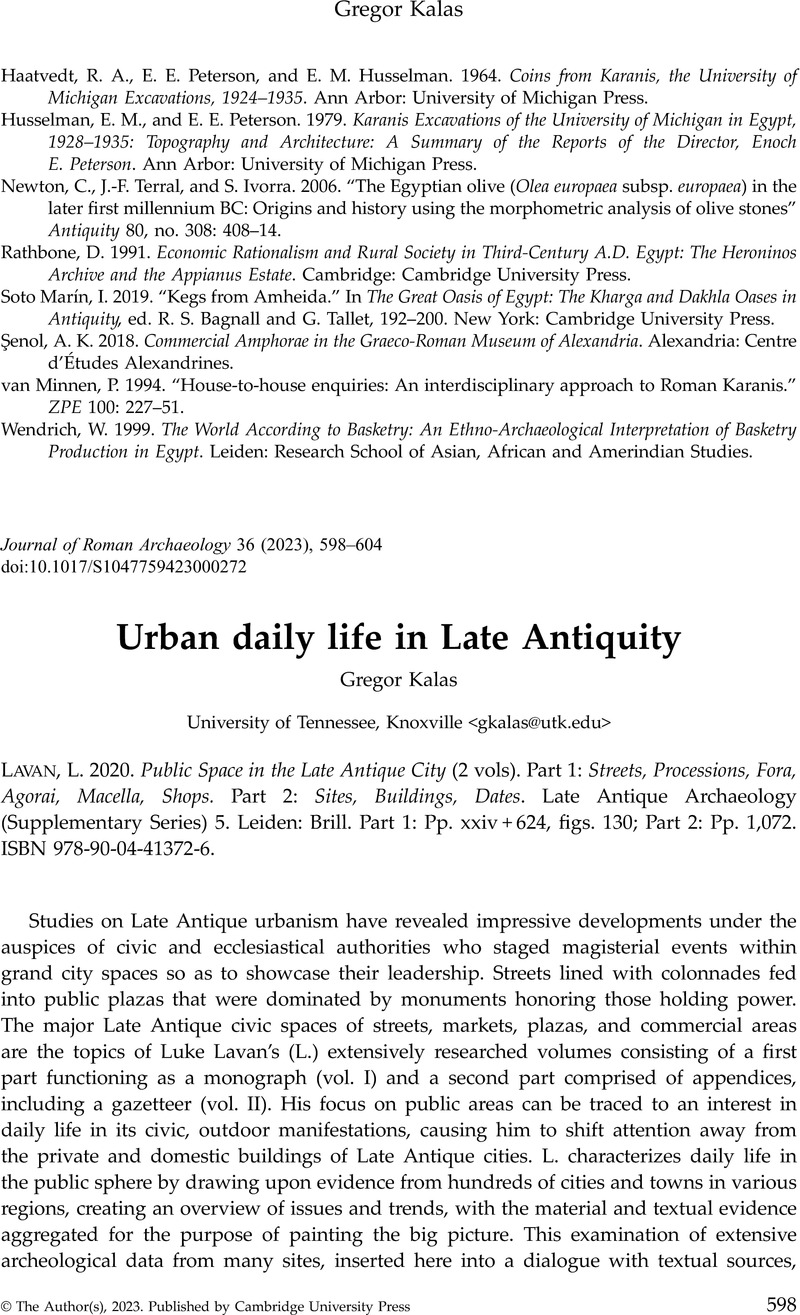No CrossRef data available.
Article contents
Urban daily life in Late Antiquity - L. Lavan 2020. Public Space in the Late Antique City (2 vols). Part 1: Streets, Processions, Fora, Agorai, Macella, Shops. Part 2: Sites, Buildings, Dates. Late Antique Archaeology (Supplementary Series) 5. Leiden: Brill. Part 1: Pp. xxiv + 624, figs. 130; Part 2: Pp. 1,072. ISBN 978-90-04-41372-6.
Review products
L. Lavan 2020. Public Space in the Late Antique City (2 vols). Part 1: Streets, Processions, Fora, Agorai, Macella, Shops. Part 2: Sites, Buildings, Dates. Late Antique Archaeology (Supplementary Series) 5. Leiden: Brill. Part 1: Pp. xxiv + 624, figs. 130; Part 2: Pp. 1,072. ISBN 978-90-04-41372-6.
Published online by Cambridge University Press: 11 August 2023
Abstract
An abstract is not available for this content so a preview has been provided. Please use the Get access link above for information on how to access this content.

- Type
- Book Review
- Information
- Copyright
- Copyright © The Author(s), 2023. Published by Cambridge University Press
References
Banaji, J. 2002. Agrarian Change in Late Antiquity: Gold, Labour, and Aristocratic Dominance. Oxford: Oxford University Press.CrossRefGoogle Scholar
Bauer, F. A. 1996. Stadt, Platz und Denkmal in der Spätantike: Untersuchungen zur Ausstattung des öffentlichen Raums in den spätantiken Städten Rom, Konstantinopel und Ephesos. Mainz: v. Zabern.Google Scholar
Dey, H. 2015. The Afterlife of the Roman City: Architecture and Ceremony in Late Antiquity and the Early Middle Ages. Cambridge: Cambridge University Press.Google Scholar
Ellis, S. 2018. The Roman Retail Revolution: The Socio-economic World of the Taberna. Oxford: Oxford University Press.CrossRefGoogle Scholar
Jacobs, I. 2013. Aesthetic Maintenance of Civic Space: The 'Classical' City from the 4th to the 7th Century AD. Leuven: Peeters.Google Scholar
Krautheimer, R. 1983. Three Christian Capitals: Topography and Politics. Berkeley: University of California Press.CrossRefGoogle Scholar
Latham, J. A. 2009. “The making of a papal Rome: Gregory I and the letania septiformis,” in The Power of Religion in Late Antiquity, ed. Lenski, N. and Cain, A., 293–304. Farnham: Ashgate Publishing.Google Scholar
Matthews, J. 2000 Laying Down the Law: A Study of the Theodosian Code. New Haven: Yale University Press.Google Scholar
Nixey, C. 2018. The Darkening Age: The Christian Destruction of the Classical World. Boston: Macmillan.Google Scholar
Saxer, V. 1989. “L'utilisation par la liturgie de l'espace urbain et suburbain: l'exemple de Rome dans l'Antiquité et le Haut Moyen Âge, ” In Actes du XIe Congrès international d'archéologie chrétienne : Lyon, Vienne, Grenoble, Genève et Aoste (21-28 septembre 1986), ed. Duval, N., 917–1033. Rome: École française de Rome.Google Scholar
Sessa, K. 2018. Daily Life in Late Antiquity. Cambridge: Cambridge University Press.CrossRefGoogle Scholar


